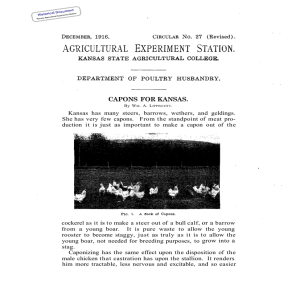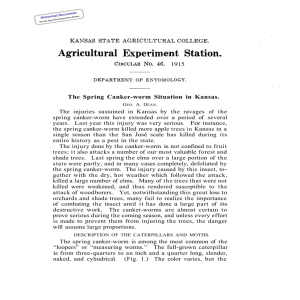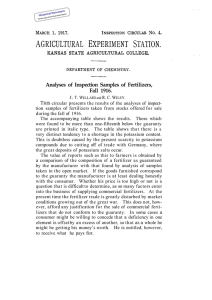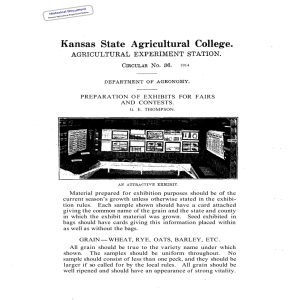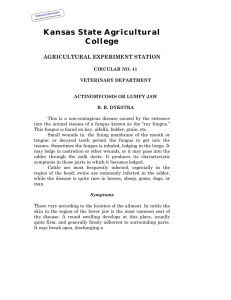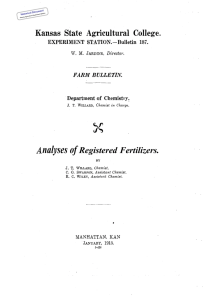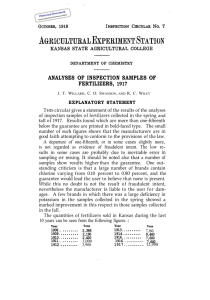Mays RELATION BETWEEN AGE AND DRY WEIGHT L.)
advertisement
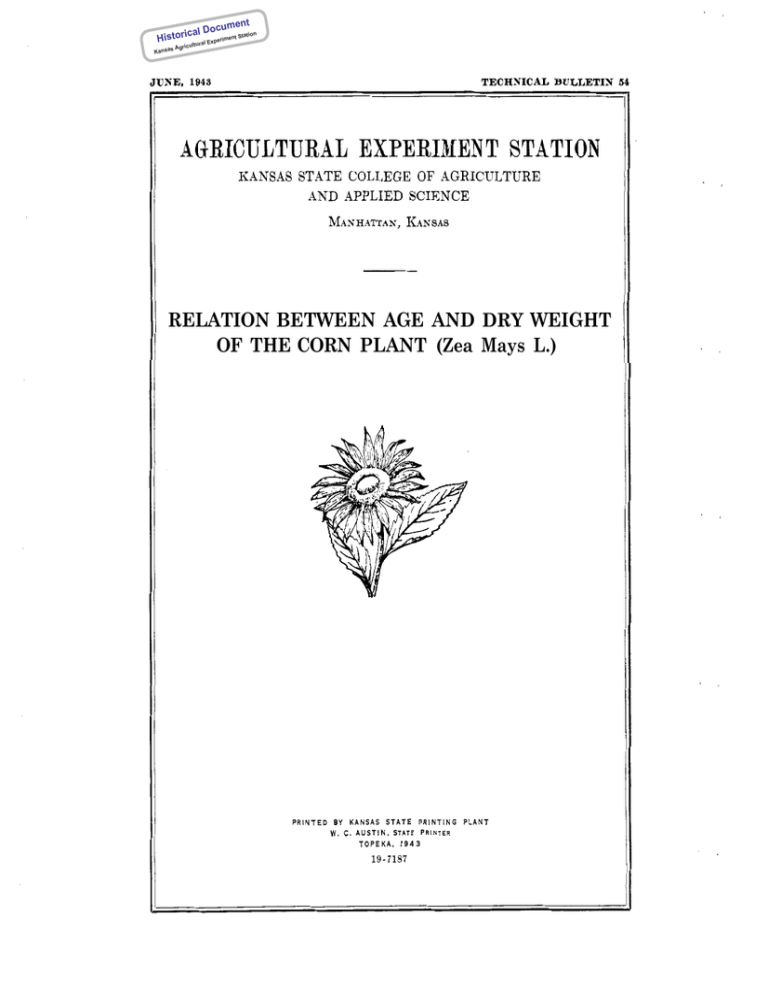
t cumen cal Do ent Station Histori rim ral Expe ultu as Agric Kans RELATION BETWEEN AGE AND DRY WEIGHT OF THE CORN PLANT (Zea Mays L.) ument c cal Do Histori riment ral Expe tu Agricul Kansas Station RELATION BETWEEN AGE AND DRY WEIGHT OF THE CORN PLANT (ZEA MAYS L.) 1 E. C. MILLER INTRODUCTION Knowledge of the physiology of plants is meager. Information that increases the general knowledge concerning them aids in attaining a better understanding of their behavior. The data presented were obtained on Kansas Sunflower corn, a yellow open-pollinated variety grown extensively in Kansas. METHOD OF GROWING AND HARVESTING THE PLANTS2 The plants used in these experiments were grown in the field a t Manhattan, Kan., during the four growing seasons of 1924 to 1927, inclusive. The seed from ordinary commercial stock was obtained annually from the Department of Agronomy of the Kansas Agricultural Experiment Station. The plants were grown in 44-inch rows and two feet apart in the row. After the plants had attained a height of four inches, they were thinned to one plant per hill and kept free of tillers. The plants showed no wilting or any other symptoms of drought during the four growing seasons. Thus, the moisture supply must have been sufficient at all times. Five representative plants were collected a t weekly intervals during each growing season by cutting them a t the ground line, washed free of adhering particles and dried t o a constant weight a t 105° C. The number of leaves, height and general appearance of the plants at various periods are shown in Table 1. METEOROLOGICAL DATA The weather data considered pertinent t o the experiment are shown in Table 2. These include the daily maximum and minimum temperatures and precipitation for the months of May, June, July and August, 1924-1927, inclusive. The normal temperatures and precipitation are the averages of these factors for the 85 years that weather records have been kept at Manhattan, Kan. 3 The monthly averages of the maximum and minimum temperatures and the precipitation together with the normal for each of the four months, are given in Table 2. ument c cal Do Histori riment ral Expe tu Agricul Kansas Station Some data not given in Table 2, but discussed herein, are the normal precipitation and actual precipitation for the first eight months of the years 1924 t o 1927, inclusive. The normal rainfall for the first, eight months of the year was 22.99 inches. The rainfall during the first eight months of 1924, 1925, 1926 and 1927 was 23.89, 20.81, 12.12 and 30.41 inches, respectively. During the first eight months of 1924 the monthly rainfall was below normal except in March when it was slightly above normal and in August when it was 6.36 inches above normal. The excess of rainfall during August caused the precipitation for this year to exceed the normal by almost an inch. The total rainfall during these eight months is therefore quite misleading when considered from the viewpoint of its beneficial effects on the corn crop as almost six inches of this precipitation occurred after August 20 when it was of little or no benefit. During the first eight months of 1925, the rainfall totalled 20.81 inches or approximately two inches below the normal. The rainfall was above the average in April and June, practically normal in August but considerably below the normal during the other months. In 1926 during the first eight months of the year the rainfall totalled only 12.12 inches, approximately half of the normal rainfall for this period. I n 1927 the rainfall for the first eight months amounted t o 30.41 inches or 7.42 inches in excess of the normal. It was below normal in January, M a y and July but exceeded it during the other five months. EXPERIMENTAL DATA The dry weight of the leaves, stem, husk, shanks and ears of each plant of each set and the average for five plants are shown in Table 3. The weight of each plant is given so that the individual fluctuations in each set may be seen. The average weight of the various parts of the five plants of each set is pictured by graphs for each of the four growing seasons in Figures 1, 2, 3 and 4. These figures show t h a t the stem and leaves reached certain weights a t approximately the same time during each of the four years. Thus in 1927 the dry weight of the stems was equal to the dry weight of the leaves between July 18 and 25. I n 1926 this ratio occurred between July 12 and 19, in 1925, about July 13 and in 1924 between July 14 and 21. This equality in weight between stems and leaves thus was attained each year within an interval of time not to exceed a week. I n 1924 the maximum dry weight of the leaves was attained on August 4, decreased markedly the next week and on August 18 it increased t o almost the same value as it showed two weeks earlier. The following week the total dry weight of the leaves declined to a value slightly in excess of what it was on August 11 and then on September 2 it had increased t o about the same value as was shown on August 18. The maximum dry weight of the stem and ear was reached on September 2, the time t h a t the last sample was taken. The husks also attained a maximum dry weight on this date, but t cumen cal Do ent Station Histori Kansas perim tural Ex Agricul t cumen cal Do ent Station Histori Ka perim tural Ex ricul nsas Ag t cumen cal Do ent Station Histori Kans ultural as Agric Experim ument c cal Do Histori Kansas tural Agricul ion ent Stat Experim t cumen cal Do ent Station Histori ultural as Agric Experim Kans the dry weight, was practically the same as i t was two weeks previous. The average dry weight of the stem, leaves and husks fluctuated very markedly after August 4. The dry weight of the shank reached its maximum on August 25 and fell slightly on September 2. I n 1925 the maximum dry weight, recorded of the stem, of the leaves, and of the ear was reached on August 24, the date that the experiment was discontinued. The dry weight of the leaves from July 20 to August 24 was very irregular but kept moving in a general upward direction. The shanks collected on August 17 had the greatest amount of dry matter and the extent of decrease the following week was within the limit of error of the experiment. I n 1926, the maximum dry weight of each of the five parts of the plant reached its maximum on August 9 when the experiment was discontinued because on August 11 a severe rain, hail and wind storm ruined for experimental study all corn in the field. I n 1927 the maximum dry weight of the leaves was on August 1, and that of the other plant parts was on August 15 when the experiment was discontinued. During all four growing seasons the greatest dry weight recorded for the stem and ears was on the date the experiments were discontinued. It is problematical whether the dry weight of these parts would have increased or decreased after this date. Certainly the variation would have been small in extent except in 1926 when it would have increased in certain parts for the plants had not as yet completed their growth on August 9 and all were then gaining in weight. I n 1926 and 1927 the dry weight recorded for the husks reached its maximum on the date that the experiment was discontinued. The dry weight recorded for the leaves reached its maximum on the final day of the experiment in 1925 and 1926. I n Table 4 is shown the average dry weight, expressed in grams, of the aerial part of the plant a t the end of each week of growth. The last column in this table gives the average weight of this part of the plant for all the four years. I n Table 5 is given the weekly average dry weight of each of the five plant parts. These data are shown graphically in Figure 5. The curves representing the changes in the dry weight of the several parts for the four-year average are much smoother than those representing the growth of these parts for each growing season as would be expected. I n approximately eight weeks after the emergence of the plant, the dry weights of the stems and of the leaves were the same, approximately 125 grams. During the succeeding five weeks the dry weight of the stems increased much faster than the dry weight of the leaves. At the end of this period, 13 weeks, the dry weight was 258.7 grams for the stem, while it was only 164.2 grams for the leaves. During the next two weeks the dry weight of the stem decreased. There are two general reasons for such a decline: (a) Loss of leaves from the plant as it becomes older, and ( b ) translocation of some of the materials found in them to the developing ear. The dry weight of the stem decreased during ument c cal Do Histori Kansas riment Expe ultural Station Agric 2 3 4 5 6 7 9 I3 F I G. average dry weight in grams of each part of the Kansas Sunflower corn plant a t the end of each week during the growing seasons of 1924, 1925, 1926 and 1927. t cumen cal Do ent Station Histori Kansas tural Agricul Experim the 14th week and then increased the following one but it did not become so high as i t was a t the end of the 13th week. The variation in the dry weight of the stem may be attributed to the differences in the rate of translocation of material from it into the ear and to the variation in individual plants. The ear, which included the cob and grain, reached its average maximum dry weight of 252.7 grams a t the close of the 14th week. The husks reached their maximum growth as measured by dry weight a t the close of the 13th week, but after that, time they rapidly declined in weight. They varied greatly in weight, for this value depends upon the number of ears per plant and to the migration of materials from them into the developing ear or ears. The variation of the dry weight of the shank is due to the same factors. The greatest percentage gains in the growth rate, expressed as the gain in dry weight of one week over what it was the previous week, occurred at the early stages of development when the actual increase in the grams of dry matter was relatively small. Thus, as shown in Table 5, the greatest weekly increase in weight expressed as percent was 581.9 and occurred a t the end of three weeks of growth; the actual increase in dry weight, however, over that of the previous week was only 3.63 grams. The next greatest increase in growth expressed as percentage occurred a t the close of the second week. It amounted to 229.4 percent, but the actual increase in weight was only 0.43 grams. The percentage gain in weight, with but one exception, gradually decreased from 581.9 a t the close of the third week period to 11.1 at the end of the 14th week. The maximum weekly gain in dry weight was 112.2 grams during the 13th week, but the percent increase over the dry weight of the previous week amounted to only 19.0. The next greatest weekly increase in dry weight was 104.88 grams and it occurred at the close of the ninth week, while 43.7 expressed the percentage gain over that of the previous week. Some of the other weekly increases in dry weight expressed in grams in order of their numerical value were 94.7, 79.1, 78.0, 74.6 and 71.2 for the 10, 11, 14, 8 and 7 week periods while the percent increases named in the same order were 27.4, 18.0, 11.1, 48.1 and 84.9. In Table 6 is shown the weekly variation in the dry weight (expressed in grams) of the five parts of the corn plant for each week of the growing seasons of 1924 to 1927, inclusive. The average gain or loss in dry weight expressed as grams for each week is shown in the next to the last column in the table. I n the last column is shown the average gain or loss expressed as percentage over that of the previous week. This value was obtained by dividing the average increase or decrease in dry weight by the average dry weight of the plant p a r t under consideration for that week. During the four years the increase or decrease of the dry weight of the leaves was determined 47 times. Eight of these determinations, or approximately 17 percent of them, showed a loss in weight. However, these losses were generally sufficiently low so that when t cumen cal Do ent Station Histori Kansas tural Agricul Experim they were averaged with the gains during the corresponding week of the other years, the negative results disappeared. There were only two cases in which the negative results were either sufficiently large or that the loss in weight occurred during the corresponding week in different years that the four-year average showed a negative result. The gain or loss in the dry weight of the stems was determined in 44 cases and in five of them, approximately 11 percent, a loss in weight was shown. I n only one instance, however, was the loss sufficiently great to influence in a negative manner the results for that week when they were averaged. This was during the 13th week and there were only two years, results in the average. The husks showed a weekly loss in dry weight only once during the four growing seasons, viz., during the 11th week in 1924, and then the loss amounted to only 1.2 grams. The greatest gains in weight expressed on a percentage basis were during the earlier stages of development but the increase in dry weight was very small. The dry weights of the ear and of the shank showed no decrease a t any time except during the 13th week in 1925, the shank showed a loss of only 0.3 gram which was within the limit of error of the experiment. The average weekly increase or decrease in the weight of the dry matter that composed the various parts of the plants is pictured in Figure 6. This graph shows the various facts mentioned in the discussion of Table 6. The average total weekly gain in dry weight of the plants for each of the four years of the experiment is given in Table 7. The average weekly gain in dry weight in grams and the percentage increase in weight over that of the previous week is shown in Figure 7. The average gain in dry weight for the plants during each day of the four growing seasons is indicated in Table 8. The average daily gain is shown in the last column. These data, pictured in Figure 8, represent only the daily increase of the aerial parts of the plant and nothing is shown relative to the increase or decrease in the dry matter of the roots since no data were obtained in t h a t regard. The average leaf surface of five plants taken at random during each week in 1925 and 1927 is shown in Table 9. These data show that the maximum leaf surface which amounted to 30 to 31 square feet was attained both years between the 13th and 25th of July. The maximum increase in leaf surface occurred in 1925 during the week beginning June 22 and in 1927 during the week beginning June 20. I n the former case this increase was 7,178 cm2 while in the latter it was 7,937 cm. 2 The percentage increase in leaf surface each week over that of the preceding week was much greater during the earlier stages of the development of the plant. I n 1925 the increase was greatest between May 25 and June 1 during which time the leaf surface was almost quadrupled in extent. I n 1927 the maximum increase was from June 8 to 15 when it was slightly over three times what it was the previous week. I n 1925 the percentage of increase ument c cal Do Histori riment Agric Kansas Expe ultural Station ument c cal Do Histori n t Statio perimen tural Ex Agricul Kansas t cumen cal Do ent Station Histori Ka perim tural Ex ricul nsas Ag t cumen cal Do ent Station Histori ultural as Agric Experim Kans in the surface of the leaves gradually decreased from the maximum percentage until it amounted to 5.8 percent during the week of July 20 or only one-fourth of what it was the previous week. I n 1927 the percentage increase of leaf surface fluctuated considerably but gradually declined until it reached a minimum of 12.5 percent on July 25 which was about two-thirds of what it was the previous week. The greatest increase in dry weight was a t or shortly before or after the plants had attained their maximum leaf surface. This is as would be expected because the greatest surface would be available to receive the maximum of sunlight to be used in photosynthesis. The maximum daily increase in dry matter of the tops was 20.22 grams and occurred during the ninth week in 1927. The next highest daily gain in dry weight occurred during the 13th week in 1925 and amounted to 18.37 grams. Four other times during the experiments the daily increase in dry matter was slightly in excess of 16 grams. These increases occurred during the 11th and 13th week of 1924, during the 10th week of 1925, and during the corresponding week in 1926. I n several instances the daily increase in dry weight was from 10 to 14 grams. From Table 7 it may be observed that in only one instance (the 12th week of 1924), during the four growing seasons did the five plants show a decrease in their dry weight. This decrease amounted to 10.7 grams for the week or a daily average of 1.5 grams. This decrease in dry weight was likely due t o a n error in sampling. During t h a t corresponding week for the years 1925, 1926 and 1927 the weekly increase in dry weight for each plant amounted to 108.32, 82.60 and 99.66 grams, respectively, which is a daily average of 15.47, 11.80 and 14.24 grams. The average daily gain for the four years was approximately 10 grams. The total dry weight of the corn plant in 1924 was 745.2 grams a t the close of the 15th week. I n 1925 the final weight was 895.88 grams a t the end of the 14th week. I n 1926 and 1927 the experiments were concluded on August 9 and 15, respectively, two or three weeks before the plants were a t their maximum weight. At that time, the total aerial dry weight of these plants was 535.46 and 652.23 grams, respectively. The average dry weight of the plants for all four years was 588.2 grams a t the close of the 12th week, the time t h a t the experiment was discontinued in 1926 and 1927. From the beginning of the ninth week when the plants had reached their full leaf development until the 12th week they increased in dry weight 69.9, 66.8, 60.4 and 65.0 percent of their final dry weight during the years 1924, 1925, 1926 and 1927, respectively. I n Table 10 is shown the percentage t h a t the leaves, stem, ear, husk, and shank each contribute to the total weight of the plant a t various stages of development. I n this table these data are given for each of the five plants and their average for each week of the four growing seasons. The results are shown graphically in Figures 9, 10, 11 and 12. I n Table 11 is shown the percentage of the total dry weight of each part of the plant at the end of each week for the t cumen cal Do ent Station Histori Kansas perim tural Ex Agricul t cumen cal Do ent Station Histori Kans ultural as Agric Experim ument c cal Do Histori n t Statio perimen tural Ex Agricul Kansas ument c cal Do Histori Kansas Ag n t Statio perimen ral Ex ricultu ument c cal Do Histori riment ral Expe tu Agricul Kansas Station growing seasons and the average percentage of these parts for the four years. From these tables and figures it is seen t h a t during the first week of growth the leaves of the corn plant constitute practically 100 percent of its dry weight. During the second week of growth for the years 1924, 1925, and 1927, the stems comprise 2.41, 2.90 and 5.16 percent, respectively, of the dry weight of the aerial parts. The percentage of the total dry weight of the plant contributed by the leaves becomes less and less, while that of the stems continues to increase as the plant becomes older. I n 1924, these two parts of the plant were equal on a dry weight basis between July 14 and 21. I n 1925 this situation occurred during the week that ended on July 13, in 1926 sometime between July 12 and 19, while in 1927 this value was attained during the week of July 18 to 25. The combined weight of these two parts for all four years was slightly less than 100 percent of weight of the entire plant. This was due to the fact that before this equal value in dry weight of the stem and leaves had been reached, the husk, ear and shank had begun to form and thus added their dry weight to the total of the plant. The leaves continued to decrease in proportion to the total dry weight so that when the experiment was concluded a t the end of each of the four growing seasons they composed 20.80, 20.28, 28.61 and 22.49 percent, respectively, of the total weight. The stems continued to increase in proportion to the entire dry weight of the plants after the end of the second week and reached a maximum of 53.02 percent on July 21, 1924, 49.88 percent on July 20, 1925, 50.52 percent on July 19, 1926, and 53.29 percent on July 25 for 1927. The percentage of the total dry weight of the plant contributed by this part began to decrease after the above dates so that it amounted to 33.90, 31.86, 38.14 and 41.31 percent, respectively, when the final weights were taken. I n 1924 the weights of the husks and the ear were first determined on July 2 1 and that of the shank one week later. By September 2 the weight of the ear composed 31.60 percent of the total dry weight, of the aerial portion of the plant, a n amount slightly lower than t h a t composed by the dry weight of the stem a t that date. The shanks ranged from 1.43 to 2.51 percent of the total dry weight of the plant. The proportion of the dry weight of the entire plant composed by the husks fluctuated more than that of any of the other five parts of the plant that were considered. This was due apparently to the great variation in the number and size of the ears. The proportion that the husks composed of the total dry weight of the plant was 3.31 percent on July 21. This proportion gradually increased until August 4, when it was 14.44 percent. This value then remained constant for the two succeeding weeks and then declined to 10.85 percent on August 25 and then increased slightly to 11.60 percent on September 2. I n 1925 the weight of the ear was determined for the first time on July 13 when it composed only 0.07 percent of the total dry weight of the plant. This proportion gradually increased until August 24 ument c cal Do Histori Kansas ion ent Stat perim tural Ex Agricul when it amounted to 32.59 percent, slightly above the proportion contributed by the dry weight of the stem a t that time. On July 13 when the dry weight of the husks was first determined, they composed 1.95 percent of the dry weight of the plant. This proportion gradually increased until on August 17 its value was 16.21 but this decreased to 11.98 percent on August 24. The weight of the shank amounted to only 0.02 percent of the total dry weight of the plant on July 13. It then increased very slowly to August 17 when it composed 3.69 percent of the total dry weight. This weight then decreased slightly to 3.29 percent during the next week but this decrease was within the limit of error of the experiment. During the growing season of 1926 the proportions of the dry weight of the plant composed by the ear, husks, and shank were gradually increasing when the experiment was prematurely concluded because of storm damage. In 1927 the dry weight of the husks was first determined on July 18 and that of the ear and shank one week later. The husks composed 1.77 percent of the dry weight of the entire plant when they were first determined and continued to increase so that on August 8 they composed 16.44 percent of the total dry weight of the plant. One week later, however, they composed only 15.51 percent of such dry weight. The dry weight of the ear was first determined on July 25 when it composed only 0.62 percent of the total dry weight. This value gradually increased and when the experiment was ended on August 15 it amounted t o 17.42 percent. The shank composed only 0.85 percent of the total dry weight of the plant on July 25 but gradually increased to 3.27 percent a t the close of the experiment. The average percentage of the total dry weight of the plant that was comprised by each of the five parts during the four growing seasons is shown in Figure 13. The stem and leaves each attained an equal proportion of the total dry weight between the eighth and ninth weeks. The stem reached its average maximum percentage of the total dry weight at the close of the ninth week. The ear continually increased in its proportion of the dry weight of the plant until the close of the experiments. The relative value of the husks increased with time until the 13th and 14th weeks when it decreased markedly and then slightly during the 15th week. The proportion of the total dry weight of the plant composed by the shank gradually attained a constant level which was maintained until the 14th week when there was slight decrease. I n Table 12 is shown the amount of water lost by transpiration for each week of the growing seasons of 1924, 1925, and 1926. Although the plants in these transpiration studies were not the same as those whose dry weights are given, they were comparable and were grown under the same conditions. The data on transpiration are shown to give a better concept of the general atmospheric conditions that prevailed during the growth experiments. In Table 13 are given the total amount of mater lost, the amount of dry matter produced by the aerial parts and the water requirement of the aerial portion of the corn plant for the years 1925 and 1926. ument c cal Do Histori Kansas riment Agric Expe ultural Station t cumen cal Do ent Station Histori Kansas tural Agricul Experim SUMMARY 1. Kansas Sunflower corn was grown in the field during the four growing seasons of 1924 to 1927, inclusive. These plants were grown in 44-inch rows two feet apart in the row. The plants were kept free from tillers or suckers and never visibly wilted during the four growing seasons. 2. Five representative plants were collected a t weekly intervals during each growing season by severing a t the ground line and their rate of growth determined by the increase in dry weight of the aerial parts. 3. The aerial portion of the plant was divided into the leaves, stem, ear (grain and cob), husks and shank. 4. The curves showing the average growth of these parts for a given season show considerable weekly fluctuations. This was due to the difficulty of selecting truly representative plant's for each sampling. The curves representing the average weight of these parts are very nearly uniform because these minor fluctuations are thus minimized. 5. At the age of eight weeks the dry weights of the leaves and of the stems were approximately equal. During the next five weeks the dry weight of the stems increased rapidly, much faster than the leaves. The ear reached its maximum dry weight at the close of the 14th week, as did the shank, while the husks attained this maximum at the close of the 13th week. 6. The greatest percentage gain in the growth rate for one week over the previous week always occurred during the earlier stages of development when the actual increase in dry weight was small. Thus, at the close of the third week the greatest average percent increase was 581.9, while the increase in dry weight amounted t o only 3.63 grams. The average maximum weekly gain in dry weight was 112.2 grams during the 13th week, but this amounted to a gain of only 19.0 percent, 7. During the four years the increase or decrease of the dry weight of the leaves was determined 47 times. Eight of these determinations, or approximately 17 percent, showed a loss in weight over that of the previous week. These decreases were sufficiently small so t h a t when averaged with the weekly results of the other years they disappeared except in two cases. In those cases the average negative results were small. 8. During the four years the gain or loss in the dry weight of the stems was determined 44 times. I n five of these cases, or approximately 11 percent, losses occurred. I n only one instance, however, was the negative result sufficiently large to give a negative value when averaged with the corresponding weeks of the other years. 9. The ears showed no loss in weight in any of the 18 times that these determinations were made. In the 17 instances that such determinations were made on the husks, a negative result was obtained t cumen cal Do ent Station Histori Kansas perim tural Ex Agricul in only one case and this disappeared in the average. The shank showed a decrease once during 1 7 determinations and then the extent was so small t h a t i t was within the limit of experimental error of the experiment. 10. The dry weight of the leaves during the first week composed practically 100 percent of that of the plant. During the second week the stem began to contribute a larger portion and between the eighth and ninth week it and the leaves comprised an equal portion of the dry weight, of the plant. At the end of the experiments the average proportion of the total dry weight comprised by the leaves amounted to 20.5 percent while that of the stems was about, 34 percent. 11. The ear a t the close of the experiments comprised approximately 32 percent of the dry weight of the plant. The husks comprised about 12 percent while the shank never composed much over 3 percent of the total dry weight of the plant. 12. The leaf surface was determined weekly during 1925 and 1927 until it reached its maximum. The rate of transpiration was found for the three years 1924, 1925, and 1926. During the years 1925 and 1926 the total amount of water transpired, the amount of aerial dry matter produced, and the water requirement of the aerial portion of the plant were determined. t cumen cal Do ent Station Histori Kans ultural as Agric Experim t cumen n io cal Do Histori tural Experiment Stat Kansas Agricul ument c cal Do Histori riment ral Expe tu Agricul Kansas Station t cumen cal Do ent Station Histori Kansas perim tural Ex Agricul t cumen cal Do ent Station Histori Ka perim tural Ex ricul nsas Ag t cumen cal Do ent Station Histori Kansas perim tural Ex Agricul t cumen n io cal Do Histori tural Experiment Stat ul Agric Kansas t cumen cal Do ent Station Histori Kansas perim tural Ex Agricul t cumen cal Do ent Station Histori Kansas tural Agricul Experim t cumen cal Do ent Station Histori Kansas perim tural Ex Agricul t cumen n io cal Do Histori tural Experiment Stat Kansas Agricul ument c cal Do Histori n t Statio perimen tural Ex Agricul Kansas t cumen cal Do ent Station Histori Kansas perim tural Ex Agricul t cumen n io cal Do Histori tural Experiment Stat ul Agric Kansas t cumen cal Do ent Station Histori Kansas perim tural Ex Agricul ument c cal Do Histori Kansas tural Agricul ion ent Stat Experim t cumen cal Do ent Station Histori Kansas tural Agricul Experim t cumen n io cal Do Histori tural Experiment Stat Kansas Agricul t cumen cal Do ent Station Histori Kansas tural Agricul Experim t cumen cal Do ent Station Histori Kans ultural as Agric Experim ument c cal Do Histori Kansas tural Agricul ion ent Stat Experim t cumen cal Do ent Station Histori Kansas perim tural Ex Agricul ument c cal Do Histori riment ral Expe tu Agricul Kansas Station t cumen cal Do ent Station Histori Ka perim tural Ex ricul nsas Ag
